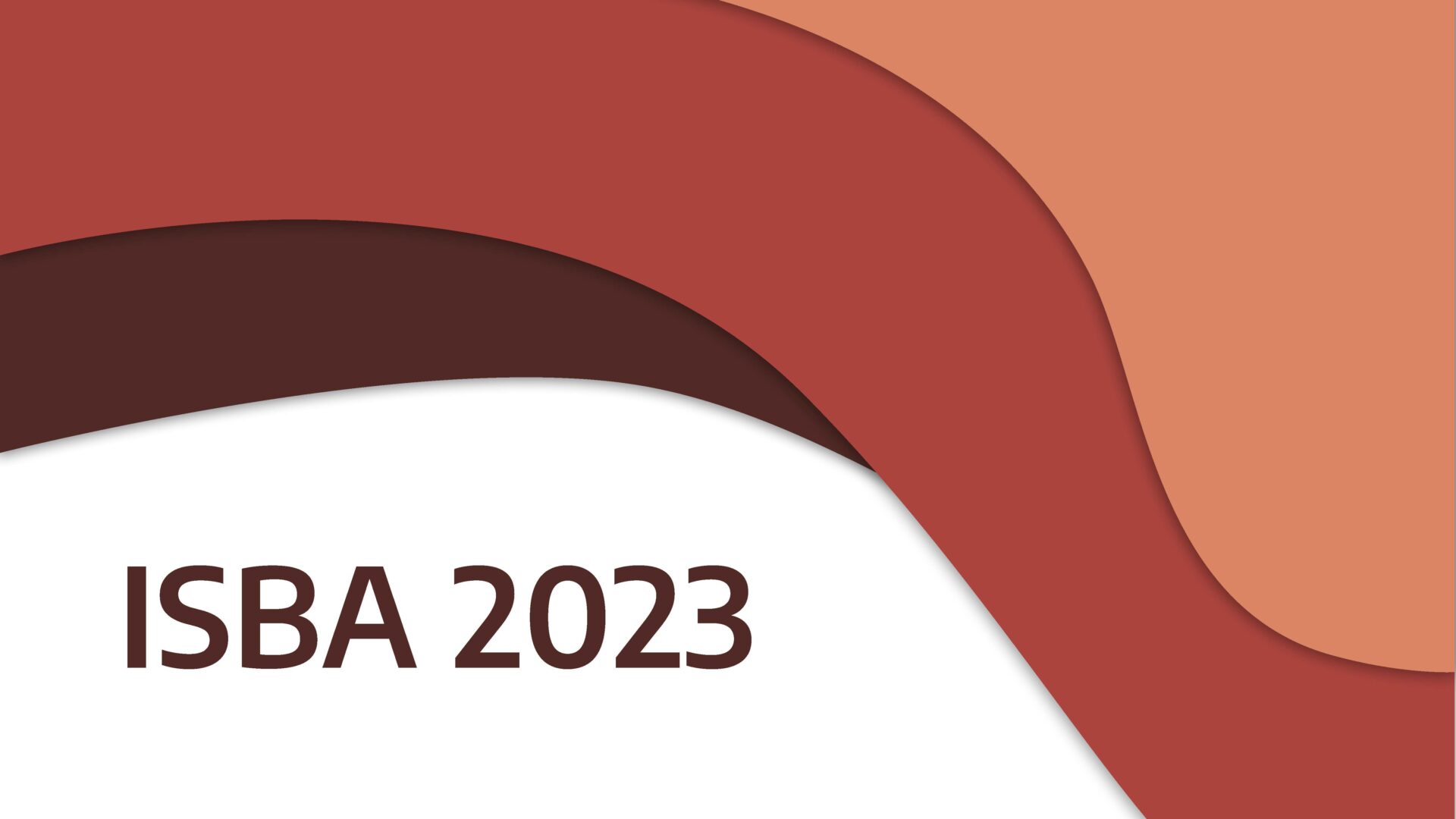International Symposium of Biomolecular Archaeology (ISBA10) took place in Tartu
A biomolecular revolution is taking place in archaeology!
Although archaeology has been inherently interdisciplinary from its early years, recent decades have seen changes referred to as the third scientific revolution in archaeology. It is driven by innovative technologies that allow past artifacts to speak at the molecular level. Where previously, pivotal historical questions – such as when certain human groups reached a particular region, what they subsisted on, what diseases they suffered from, etc – were investigated by tracing the movement of pots, biomolecular archaeology seeks answers to these questions by analysing the molecules preserved in pots and bones. Among other things, innovative methods enable us to answer previously unanswered questions and pose new questions about the past.
Biomolecular archaeology brings together archaeologists, historians, biologists and chemists. From September 13th to 15th, the tenth International Symposium of Biomolecular Archaeology (ISBA10) took place at the Estonian National Museum in Tartu, marking the first in-person gathering post-COVID. With nearly 400 participants, the conference provided a comprehensive overview of the field, covering various research topics, from the domestication of different species to ancient diseases and migrations, as well as the methods employed. The conference abstracts are available here.
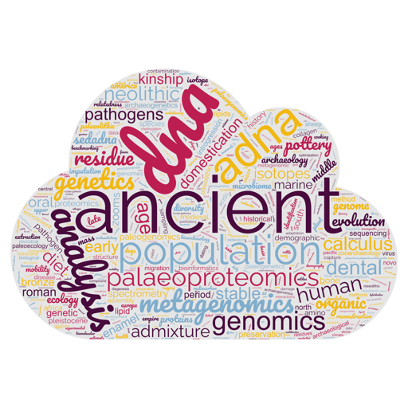
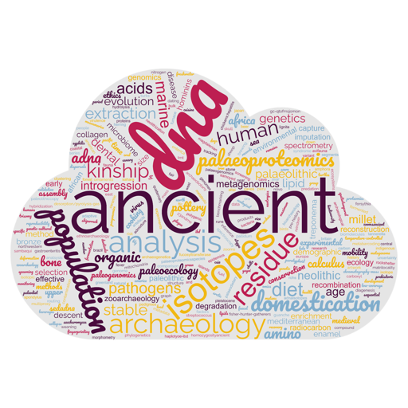
Word cloud of keywords of oral and poster presentations of the conference and word cloud of topics that were the focus of oral presentations only (Figure: E. Oras)
Genetics, one sub-field of biomolecular archaeology, is rapidly evolving. Today, it no longer focuses solely on major migrations based on the analysis of human remains, but new technologies offer insights into ancient diseases, the environment, and even the presence of people where their remains are absent. For example, today we can obtain information about people from ancient chewing-gums or worn jewellery. Environmental samples may one day enable us to speak about the genes of the first inhabitants of Estonia, the Pulli women and men, without studying their bones (which we currently do not even have), as demonstrated by Benjamin Vernot and his research group when studying Neanderthal caves.
Biology plays a role in explaining social structures and studying pathogens. In addition to studying migrations, social structure and kinship in societies is analysed in collaboration with archaeologists. For example, Guido Alberto Gnecchi-Ruscone discussed a kinship network of the 7th-century Avars in the Carpathian Basin. Greger Larson and Aurélie Manin presented the search for the source of virulence of a virus in chickens. Next to the most recent directions and methods, it is important to already think about how to gain even more knowledge of the past moving forward. Martin Petr spoke about the future potential of simulating genomic data of past populations.
Lipids, proteins, and carbohydrates – their molecules have been preserved in various ancient objects as burnt food crust or by being absorbed into the surface of a pot, in animal and human bones, and other tissues, as well as in plants. Stable isotope analysis of bone collagen provides a general picture of the diets of ancient people. By investigating stable isotopes of individual amino acids, we can better distinguish between terrestrial and aquatic origin of proteins. This was vividly demonstrated by Kyungcheol Choy, who studied the diet of the Vikings from Aarhus. Increasingly, different methods are brought together within one project to obtain a more detailed and accurate picture of the past. Ester Oras’ presentation on the Neolithization of the Baltic region, where the first farmers and hunter-gatherers coexisted side by side but in separate worlds, serves as an excellent example.
The material heritage studied through biomolecular archaeology methods is an irreplaceable resource. It is our shared natural and cultural heritage! Therefore, it must be treated sustainably – obtaining maximum information with minimal damage. Today, methods allow us to determine which species a bone belonged to simply by rubbing the bone surface with an eraser. As demonstrated by Geneviève Pothier-Bouchard, the best and most sustainable solution for classifying animal bones is using novel mass-spectrometry methods in combination with classical zooarchaeology. Moreover, science aims to become even more precise in dating historical events – for instance, it is possible to date burnt food residues on the walls of ancient pottery based on individual biomarkers, as mentioned by Mélanie Roffet-Salque in her presentation. This minimizes physical damage to the object, and the information about the timing of past events becomes more accurate. However, researchers must continually question the justification of using centuries and millennia-old human remains as research resources, and whether the scientists’ perspective aligns with, for example, the institutions curating collections, as Rita Peyroteo-Stjerna reminded us in her presentation. When analysing human remains or other archaeological objects, it is important to leave a mark – a scientific publication, of course, but the field of biomolecular archaeology is increasingly recognizing the need for data standardization and accessibility, as demonstrated by James Fellows Yates in his presentation on a community-based approach to data integration.
Biomolecular archaeology cannot be the domain of nerds quietly working in the lab. Both keynote speakers at the conference, Anne Stone (Arizona State University, USA) and Carl Heron (British Museum, UK), provided a broader insight into the developments of biomolecular archaeology. The former focused on one catalyst of the revolution, ancient DNA research, the significance of which for society was highlighted by the Nobel Prize awarded to Svante Pääbo, one of the leaders in the field, in 2022. Carl Heron, whose research focuses on the chemical composition of organic food residues preserved in pots, provided an excellent framework for the history of biomolecular archaeology and urged the community to think more about bringing scientific results to the public.
Biomolecular archaeology is an excellent example of integrating different scientific fields. One cannot exist without the other: without questions from the humanities and an understanding of the bigger picture, the “peaks” and “sequencing libraries” obtained using scientific methods are not meaningful, as Beatrice Demarchi emphasized in her presentation. Conducting analyses just because we can is neither sustainable for heritage nor does it contribute to understanding history. On the other hand, without new technologies, many questions that humanize the past would remain unasked.
Organizers
The conference was organized by: the University of Tartu and the Geenikeskus Foundation.
The organization of the conference was supported by: the Collegium for Transdisciplinary Studies in Archaeology, Genetics, and Linguistics of the University of Tartu, the Faculty of Arts and Humanities, Faculty of Science and Technology; the International Society for Biomolecular Archaeology (ISBA); the city of Tartu; the European Union through the PaleoMIX (No 101079396) and cGEM (No 810645) projects.
ISBA10 in numbers
Participants: 403
No of Keynote Speakers: 2
No of Invited Speakers: 5
No of oral presentations: 80
No of flash talks: 24
No of posters: 213
Prizes: 6
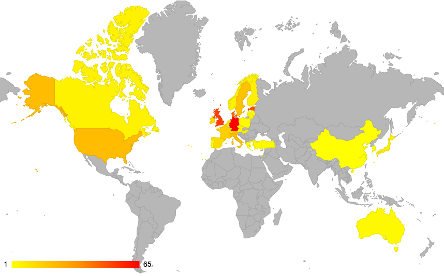
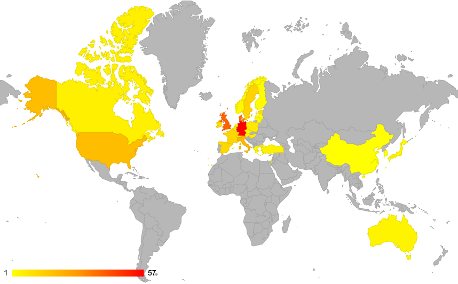
“Hot map” of the geographical distribution of participants and presenters at the conference. (M. Keller)
Prizes
Poster prizes:
Sanni Peltola, University of Helsinki / Max Planck Institute for Evolutionary Anthropology, “The Noaidi of Giggajávri (Fi. Kitka) – Life history of a Sámi shaman found in Kuusamo, Finland”
Maxime Borry, Max Planck Institute for Evolutionary Anthropology / Leibniz Institute for Natural Product Research and Infections Biology, “Reconstructing ancient microbial genomes from the wine ferments of the Roman biblical king Herod”
Presentation Prize:
Zandra Fagernäs, University of Copenhagen, “Cleaning the Dead: Decontamination of skeletal elements for palaeoproteomics”
Jan Dekker, University of York / University of Copenhagen, “Recovering proteins from foodcrust, biased from the start
Outstanding Student Publication:
Elena Essel, Max Planck Institute for Evolutionary Anthropology,
Essel, E., Zavala, E.I., Schulz-Kornas, E. et al. Ancient human DNA recovered from a Palaeolithic pendant. Nature 618, 328–332 (2023). https://doi.org/10.1038/s41586-023-06035-2
Distinguished Publication Award:
Cosimo Posth, University of Tübingen,
Ferraz, T., Suarez Villagran, X., Nägele, K., …, Posth, C., Genomic history of coastal societies from eastern South America. Nat Ecol Evol 7, 1315–1330 (2023). https://doi.org/10.1038/s41559-023-02114-9

